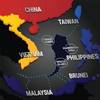Traditionally, Italy’s location and coastal development have continued to ensure the country a flow of income from its role as a strategic European hub in what has come to be known as the new “maritime century.” The country boasts of having the largest ferry fleet, the twelfth most extensive merchant shipping fleet in the world (fourth in Europe), and the third biggest European fishing fleet, with the national maritime cluster generating 3% of GDP. But its growing cruise industry is being looked upon as the game changer to the gradual slump being witnessed in the other sectors.
Italy remains “one of the most important destinations, the market of origin for large cruise lines and a world leader in shipbuilding. The Italian economy, in Europe, has benefited the most from the cruise industry, with over €4.6 billion of direct business impact in 2014 and over 102,000 jobs involved in the sector (equal to around a third of the total in Europe,” according to the “Economic contribution report 2015” presented by CLIA (Cruise Lines International Association), the organization that represents European cruise operators.
Already in the early 1900s the two shipbuilding centers of Genoa and Trieste were unrivalled players at world level building ships which already then stood out for their design, elegant interior furnishings and engineering solutions. Of the many ships built, the ‘Rex’ is worthy of special mention, as possibly the most famous, classical Italian transatlantic liner, the epitome of luxury and elegance. Built at Genoa shipyard, the Rex is remembered for winning the Blue Riband in 1933, having beaten the record for crossing the Atlantic, a record won by few other transatlantic liners.
While the shipbuilding industry, at a global level, began going through a period of transition, the cruise shipbuilding sector in Italy however, fluctuated but stayed strong. Fincantieri Spa, D’Apollonia, Rodriguez Spa, Ferretti Yachts, Azimut-Benetti, Leopard Yachts and FIPA Group are some builders who are established undisputed leaders in the world of shipping and marine defense. Helped by the specialization of Italian companies, which had the dynamism to build large ships, the state-controlled Fincantieri and luxury cruise ship maker T Mariotti this sector weathered various fiscal storms.
Fincantieri, the largest shipbuilder in Europe, after the acquisition of VARD in 2013 had as a group doubled in size to become the fourth largest in the world. The company builds both commercial and military vessels. It was Fincantieri to be the first in the 1980s to take up the opportunity of the new trend in the cruise tourist industry and it approached the market by drawing on its experience and the prestige acquired in previous decades as builder of transatlantic liners.
The Crown Princess, delivered in 1990, is perhaps one of the most beautiful ships of our time with its dolphin skyline evoking the sea, designed by Renzo Piano. This ship is the forefather of a fleet of over 50 cruise ships built by Fincantieri, flag bearers of technology and design, engineering capacity and creativity. The leadership gained with a distinctive product “Made in Italy,” is the result of top quality and a privileged relationship with the best international customers.
Thanks to its constant attention to Research and Innovation, Fincantieri continually develops new generations of ships in order to follow, indeed often anticipate, demands from the market and ship owners. Fincantieri continues to serve all sectors of the cruise market with a wide range of vessels which includes Post-panamax and Panamax ships as well as medium-small super luxury vessels or ships for special voyage types (expedition cruise, etc.)
In 2014, the cruise industry in Italy did see a slump and it recorded growth well below European competitors. Last year although, the sector in Italy grew by 0.7%, against 2.5% in 2015. This slowdown in Italy has been considered “alarming,” considering that competitors are gaining ground and growing at a much faster rate,” said the CLIA report.
During the 12 months of 2015, however, the industry recorded orders for around 40 million of compensated gross tons, down 10-15% compared to 2014. In particular, demand of offshore rigs of all sizes has essentially vanished as a result of falling oil prices and the inevitable drop in spending on exploration & production by a majority of oil & gas industry operators. Though Fincantieri recorded first-half losses, hit by the offshore sector its revenues increased, mostly driven by cruise ships. The cruise shipbuilding boom is a positive sign for the Italian industry. Of 216 cruise ships built worldwide from 1990 until last year, 70 were built by Fincantieri.
Cruise tourism in Italy impacts all of the major aspects of the industry, including: ports of embarkation, ports-of–call, shipbuilding, ship maintenance, provisioning, sales and marketing and the staffing of cruise ships and administrative facilities. Fiscal and economic conditions in Italy during 2014 continued to constrain the growth in demand. In addition the contraction in deployed capacity has resulted in a reduction in cruise passengers and crew visits.
But the potential responsible for Italy becoming a leading center for cruise ship construction in Europe is its being the largest cruise embarkation and destination market. Last year it benefitted to the extent of €4.6 billion in direct cruise industry expenditures, an increase of 0.7% over 2013. The fact is that the cruise industry enjoyed dynamic growth over a period of 30 years, driven initially by demand from North America and more recently by growing demand from Europe and the rest of the world.
Italian ports, led by Venice, Civitavecchia, Savona and Genoa, were European market leaders with 1.95 million passenger embarkations in 2014. Led by Civitavecchia, Naples, and Livorno, Italian ports also hosted 6.17 million passenger visits in 2014 making Italy the largest cruise destination in Europe.
Since the cruise ship order book peaked in 2007, new orders fell in each of the next three years. As a consequence, the growth in shipbuilding expenditures declined in 2008 and actual expenditures fell during the 2009–11 period. Despite the increase in the total order book during 2014 the contracts placed in Japan and potentially in China represent a threat to Europe’s continued pre-eminence in cruise shipbuilding. According to government sources the Italian cruise industry will continue its move ahead having posted expenditures for new-buildings in 2014 at €1,201 million and for refurbishment at €127 million. There is no doubt that Italy will continue to retain its leadership position which it has maintained over the past 40 years.
As published in the February 2016 Edition of Maritime Reporter & Engineering News: http://digitalmagazines.marinelink.com/nwm/MaritimeReporter/201602/










